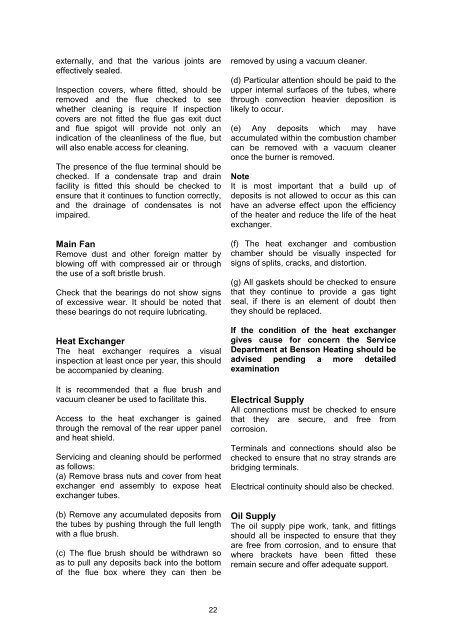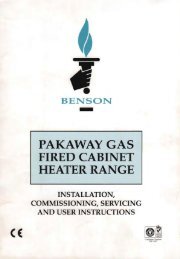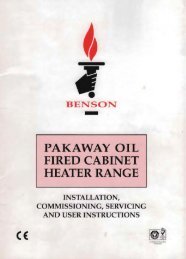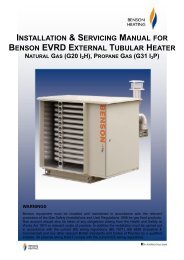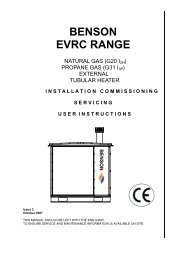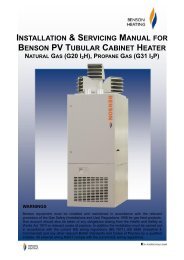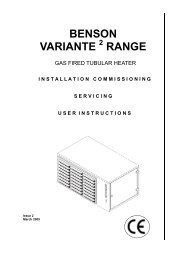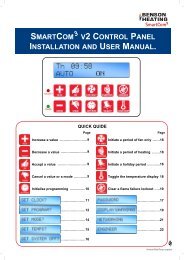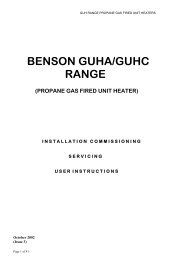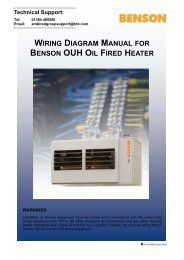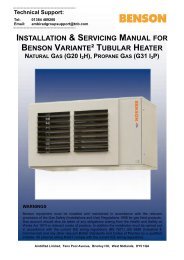BENSON OUH² OIL UNIT HEATER
Benson OUH2 Range OandM 3365190 Apr2012 issue7 ... - AmbiRad
Benson OUH2 Range OandM 3365190 Apr2012 issue7 ... - AmbiRad
- No tags were found...
You also want an ePaper? Increase the reach of your titles
YUMPU automatically turns print PDFs into web optimized ePapers that Google loves.
externally, and that the various joints are<br />
effectively sealed.<br />
Inspection covers, where fitted, should be<br />
removed and the flue checked to see<br />
whether cleaning is require If inspection<br />
covers are not fitted the flue gas exit duct<br />
and flue spigot will provide not only an<br />
indication of the cleanliness of the flue, but<br />
will also enable access for cleaning.<br />
The presence of the flue terminal should be<br />
checked. If a condensate trap and drain<br />
facility is fitted this should be checked to<br />
ensure that it continues to function correctly,<br />
and the drainage of condensates is not<br />
impaired.<br />
Main Fan<br />
Remove dust and other foreign matter by<br />
blowing off with compressed air or through<br />
the use of a soft bristle brush.<br />
Check that the bearings do not show signs<br />
of excessive wear. It should be noted that<br />
these bearings do not require lubricating.<br />
Heat Exchanger<br />
The heat exchanger requires a visual<br />
inspection at least once per year, this should<br />
be accompanied by cleaning.<br />
It is recommended that a flue brush and<br />
vacuum cleaner be used to facilitate this.<br />
Access to the heat exchanger is gained<br />
through the removal of the rear upper panel<br />
and heat shield.<br />
Servicing and cleaning should be performed<br />
as follows:<br />
(a) Remove brass nuts and cover from heat<br />
exchanger end assembly to expose heat<br />
exchanger tubes.<br />
(b) Remove any accumulated deposits from<br />
the tubes by pushing through the full length<br />
with a flue brush.<br />
(c) The flue brush should be withdrawn so<br />
as to pull any deposits back into the bottom<br />
of the flue box where they can then be<br />
removed by using a vacuum cleaner.<br />
(d) Particular attention should be paid to the<br />
upper internal surfaces of the tubes, where<br />
through convection heavier deposition is<br />
likely to occur.<br />
(e) Any deposits which may have<br />
accumulated within the combustion chamber<br />
can be removed with a vacuum cleaner<br />
once the burner is removed.<br />
Note<br />
It is most important that a build up of<br />
deposits is not allowed to occur as this can<br />
have an adverse effect upon the efficiency<br />
of the heater and reduce the life of the heat<br />
exchanger.<br />
(f) The heat exchanger and combustion<br />
chamber should be visually inspected for<br />
signs of splits, cracks, and distortion.<br />
(g) All gaskets should be checked to ensure<br />
that they continue to provide a gas tight<br />
seal, if there is an element of doubt then<br />
they should be replaced.<br />
If the condition of the heat exchanger<br />
gives cause for concern the Service<br />
Department at Benson Heating should be<br />
advised pending a more detailed<br />
examination<br />
Electrical Supply<br />
All connections must be checked to ensure<br />
that they are secure, and free from<br />
corrosion.<br />
Terminals and connections should also be<br />
checked to ensure that no stray strands are<br />
bridging terminals.<br />
Electrical continuity should also be checked.<br />
Oil Supply<br />
The oil supply pipe work, tank, and fittings<br />
should all be inspected to ensure that they<br />
are free from corrosion, and to ensure that<br />
where brackets have been fitted these<br />
remain secure and offer adequate support.<br />
22


